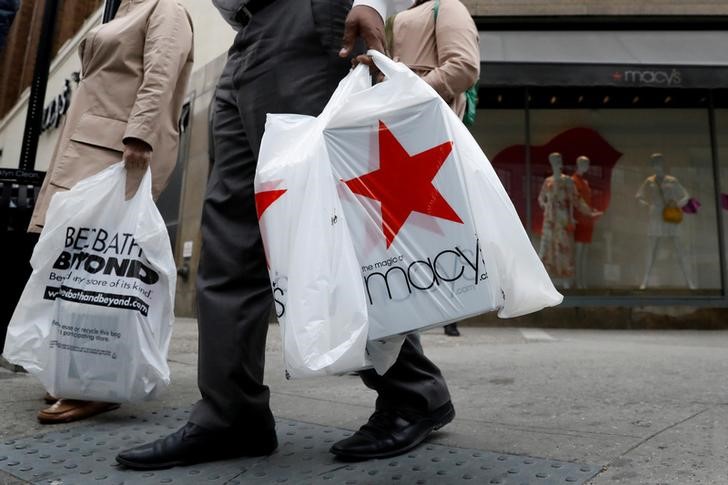By Lucia Mutikani
WASHINGTON (Reuters) - U.S. retail sales recorded their biggest increase in seven months in July as consumers boosted purchases of motor vehicles and raised discretionary spending, suggesting the economy continued to gain momentum early in the third quarter.
Retail sales for June and May also were revised higher, which should help to assuage concerns about consumer spending after a slowdown at the start of the year. Tuesday's upbeat report from the Commerce Department likely keeps the Federal Reserve on course to raise interest rates again in December.
"American shoppers flocked to the malls in July, suggesting consumers are well-positioned to propel the economy forward in the second half of the year," said Sal Guatieri, a senior economist at BMO Capital Markets in Toronto. "It should tamp down chatter about the Fed delaying rate hikes until next year."
Retail sales jumped 0.6 percent last month, the largest gain since December 2016. June's retail sales were revised to show a 0.3 percent gain instead of the previously reported 0.2 percent drop.
Economists had forecast retail sales increasing 0.4 percent in July. May's retail sales were revised to show no change rather than the previously reported 0.1 percent dip. Retail sales increased 4.2 percent in July on a year-on-year basis.
Excluding automobiles, gasoline, building materials and food services, retail sales surged 0.6 percent last month after an upwardly revised 0.1 percent gain in June. These so-called core retail sales, which correspond most closely with the consumer spending component of gross domestic product, were previously reported to have dipped 0.1 percent in June.
The report helped to shift investors' attention from recent weak inflation data as markets try to forecast the Fed's next policy move. The U.S. central bank has raised rates twice this year and economists expect it will announce a plan to start unwinding its $4.2 trillion portfolio of Treasury bonds and mortgage-backed securities in September.
The dollar (DXY) rose to near a three-week high against a basket of currencies on Tuesday, while prices for U.S. Treasuries fell. Stocks on Wall Street were mixed. Consumer spending, which accounts for more than two-thirds of U.S. economic activity, increased at a 2.8 percent annualized rate in the second quarter after a tepid 1.9 percent pace in the January-March period. That boosted GDP growth to a 2.6 percent rate in the second quarter.
But persistently sluggish wage growth has pushed Americans to dip into their savings to fund spending. Economists say wage growth has to pick up to sustain consumer spending. Annual wage growth has struggled to break above 2.5 percent.
LOW SAVINGS A CONCERN
The saving rate has dropped to 3.8 percent in the second quarter of this year from a rate of 6.2 percent in the second quarter of 2015. Low savings and tepid wage growth suggest households would need to borrow to maintain spending.
"The decline in the saving rate, however, raises some longer-term concerns about consumer spending," said Michael Feroli, an economist at JPMorgan (NYSE:JPM) in New York. "Savings can't drop indefinitely and future consumption growth will need to rely on stronger income growth."
For now, the near-term outlook for the economy is brightening. The retail sales report prompted the Atlanta Fed to raise its third-quarter GDP estimate by two-tenths of a percentage point to a 3.7 percent rate.
A second report on Tuesday from the New York Fed showed its Empire State general business conditions index climbed 15.4 points to 25.2 in August, the highest level in nearly three years. Manufacturers in the region reported a jump in new orders and said they were taking longer to deliver goods.
While a third report from the Commerce Department showed the biggest gain in business inventories in seven months in June, the stock accumulation appeared planned amid rising sales.
Retail sales in July were lifted by a 1.2 percent jump in motor vehicle sales, the biggest rise since December 2016. Sales were likely boosted by hefty discounts as auto dealerships try to reduce inventory.
Prices for new motor vehicles recorded their biggest drop in nearly eight years in July and have decreased for six straight months. A fourth report from the Labor Department on Tuesday showed imported motor vehicle prices fell in July for the second consecutive month.
Retail sales in July were also buoyed by a 1.2 percent increase in receipts at building material stores. Sales at online retailers vaulted 1.3 percent last month, the largest gain since December 2016, likely buoyed by Amazon.com's (O:AMZN) Prime Day promotion.
Sales at restaurants and bars rose 0.3 percent as did receipts at sporting goods and hobby stores.

But sales at electronics and appliance stores slipped 0.5 percent last month. Sales at clothing stores fell 0.2 percent. Clothing retailers are struggling with falling traffic in shopping malls and increased competition from Amazon and other online retailers.
